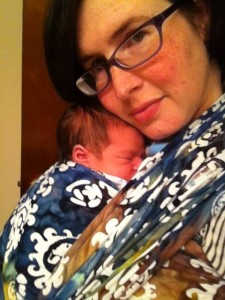The Benefits of Babywearing from LLI
The Benefits of Babywearing from Ask Dr. Sears
The Benefits of Babywearing Vs. Carseat Carrying
Infant Reflux and Babywearing:
A Happy Coexistence
By Laura Heller, M.Ed.
My name is Laura, and I found my way to the world of babywearing because my baby was born with severe Gastroesophageal Reflux Disease (GERD), which is also known as infant reflux. Jonah was in the Neonatal Intensive Care Unit (NICU) at birth. When he was brought to the nursery right after he was born, for observation, he turned blue. He had what is called apnea episodes, which means he stopped breathing. After running some tests, the doctors found that he had severe GERD. Acid went so far up his esophagus that his lungs shut down to protect themselves. Jonah was sent home on a monitor, which monitored for apnea and bradycardia (slowing of the heart rate).
Parents of GERDlings wonder, “Why does my baby have reflux?” Some possible causes are listed here. In my son’s case, it was not related to anything he was eating, for he had these episodes right after birth. For Jonah, it was an immature lower esophageal sphincter (LES). He was ‘just born with it.’ For others, it can come from a milk or soy protein intolerance (MSPI) or an allergy to these proteins (learn about the difference between allergy and intolerance). Severe protein intolerances and allergies can result in eosinophilic disorders. There are also those babies who have reflux because they are born with pyloric stenosis (when the muscles in the pylorus, the lower part of the stomach leading to the small intestine, are so enlarged they prevent food from emptying out of the stomach) or a hiatal hernia (a hiatal hernia is when a portion of the stomach protrudes upward into the chest through an opening in the diaphragm).
Caring for an infant with reflux is very challenging. Reflux causes pain, because stomach acid is traveling up the esophagus and burning it. There are two kinds of reflux. ‘Silent’ reflux and ‘regular’ reflux. Silent reflux is what Jonah had. It is when the acid travels up and then back down the esophagus, causing a ‘double’ burn. ‘Regular’ reflux is when the acid travels up the esophagus and the baby spits it out. Silent reflux often goes undiagnosed because it is a common misperception that a baby needs to spit up in order to be diagnosed with reflux. Another common misperception is that a baby needs to be losing weight (from spitting up) in order to be diagnosed with reflux. Many babies actually gain weight just fine, for they find comfort in feeding. Jonah was a comfort feeder and never had any issues with weight gain.
I was at my wits end caring for Jonah, my poor infant who was howling and shrieking in pain, when my sister lent me her ring sling (it was a commercial padded sling). While I could manage the ‘cradle’ position, I could not figure out how else to use it. (I later learned that ‘commercial’ slings are often too big for the wearer and this, combined with a closed tail, made adjusting the sling difficult for me.) I hopped on the internet and surfed on in to an amazing babywearing world!
At this time, I also found an amazing infant reflux community online. I researched all I could to be an advocate for my poor shrieking, howling baby. There are medications to help with GERD, but it can take a lot of trial and error to find the right combination and doses. I soon became a prolific poster and started to spread the joy and practicality of babywearing to my reflux forum neighbors. In fact, I helped one mother from the reflux board meet another mother from the babywearing board. Now, the mother I helped match has her very own babywearing business! I have helped many parents of GERDlings discover the joys, and practicality, of babywearing.
GERDlings are known to be ‘fussy’ babies. In fact, I have seen one too many babies with reflux diagnosed as ‘colicky‘ when in fact the poor baby has reflux! Keeping a GERDling upright after feeding is very important for their digestive systems and keeping them on an incline, when lying down, helps to keep them comfortable. They need to be held a lot because they are so uncomfortable and movement, while being held upright or on an incline, calms them down tremendously. With Jonah in a carrier, I could go about doing simple housework because my arms were free as he benefited from my movement. A carrier aids care-givers’ tired arms while achieving this task.
After finding the babywearing community, and researching carriers, I bought a pouch. I was intimidated by ring slings and thought the pouch would be the easiest carrier with which to begin. Babywearing not only saved me and my baby, but it saved my entire family! My husband started to use my pouch after he saw how much it helped calm our son, and I then got him one of his own. My mother even used the pouch when babysitting because she could see it stopped Jonah from crying so much.
I am so thrilled I can help people be more aware of my two passions, Infant Reflux and Babywearing. If you know of someone who has a ‘fussy’ baby, please let them know about this article and about Infant Reflux and the world of Babywearing. I hope babywearing will continue to ‘save’ others as it has for me and for the many others who have made this journey.
If you would like to learn more about infant GERD, you may read further:
I have found the following to be things that doctors tell parents of GERDlings that are not quite ‘true’:
You do NOT have to quit breastfeeding! The Breastfeeding and Reflux page is full of great, practical information. There are some circumstances, where it might become necessary, such as if your baby is diagnosed, through testing, with an eosinophilic disorder. If this is the case, then you can discuss it with your baby’s Pediatric Gastroenterologist. Many doctors have outdated ideas and will tell a breastfeeding mother that it is her milk that is bothering her baby and she must stop breastfeeding. This is only PARTIALLY correct. There may be specific proteins that are passed through the mother’s milk that affect the baby, but through diet mothers can learn to detect what, if any, foods she is eating that are affecting her baby. The most common proteins that cause reflux symptoms are milk and soy proteins. An intolerance to these proteins is known as ‘milk soy protein intolerance’, or MSPI.
Another outdated notion is thickening breastmilk. Doctors often tell breastfeeding mothers to pump their milk, thicken the expressed milk (EBM) with cereal and feed their babies bottles of EBM. You do not have to thicken your breastmilk. You can get help with breastfeeding your GERDling; La Leche League and lactation consultants can help you if your doctor has told you to thicken your breastmilk. (Some claim that thickening breastmilk has helped them. I never did, nor was it ever suggested to me, so I must put this disclaimer). As always, research is key.
I have found that many pediatricians prescribe zantac & reglan ‘just because.’ Reglan is for delayed gastric emptying (DGE) and there is a test to determine this. Your baby might not even need reglan and it is routinely prescribed right away, without the appropriate testing to determine if it is even necessary. In addition, if your baby is diagnose with DGE there are other drug options. If you think there is something wrong with your baby and you do not think it is simply ‘colic’ then please get to a Pediatric Gastroenterologist. Just the fact that you have found this information to be helpful means that your baby is in pain and you need help from a specialist! You are your baby’s advocate. You know best! You baby will not simply ‘grow out’ of reflux.
Related:
And in French! Porter un bébé qui souffre de reflux gastro-œsophagien
Creating a Normal Life with Severe Food Allergies: Our Adventures in Toddler Wearing





